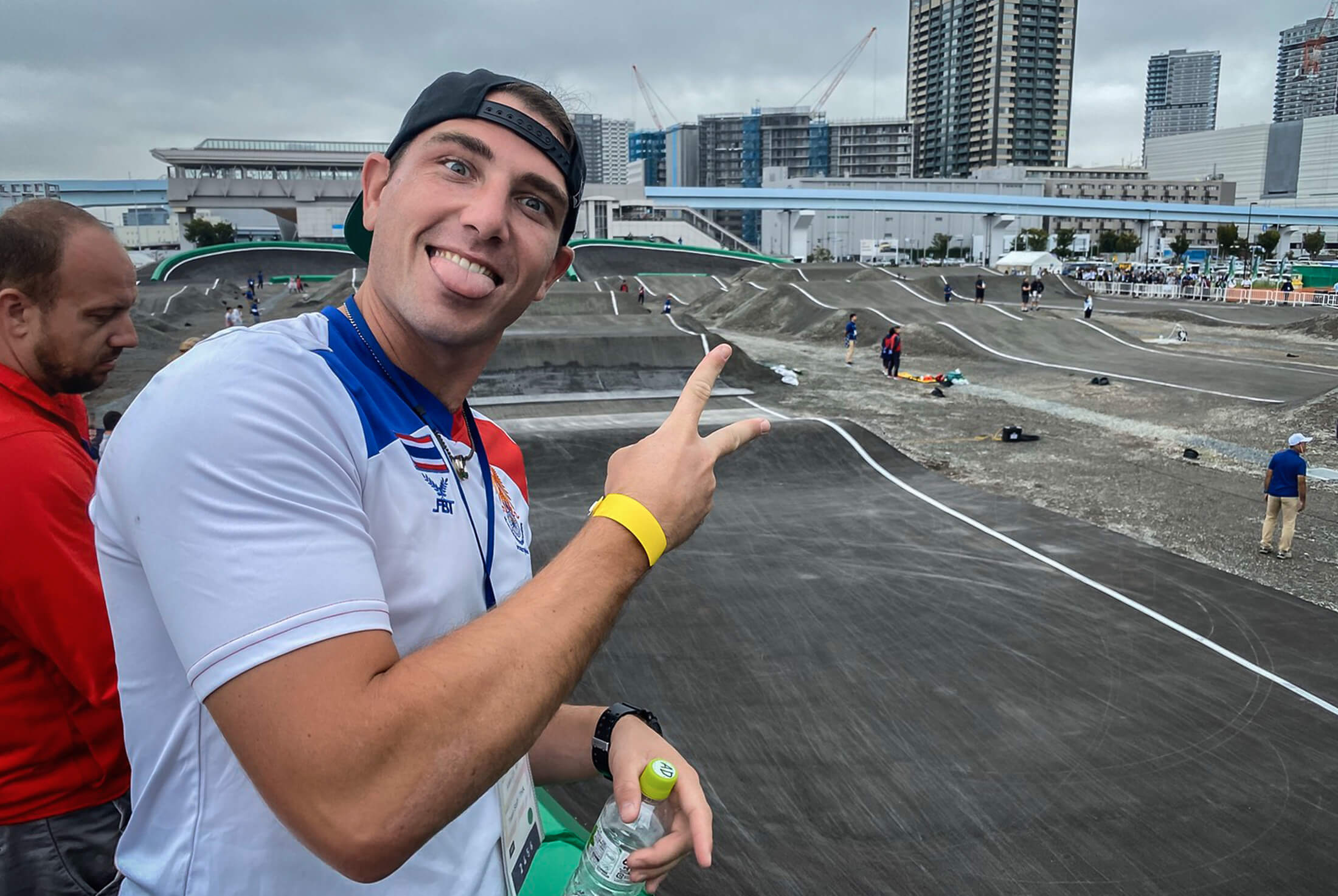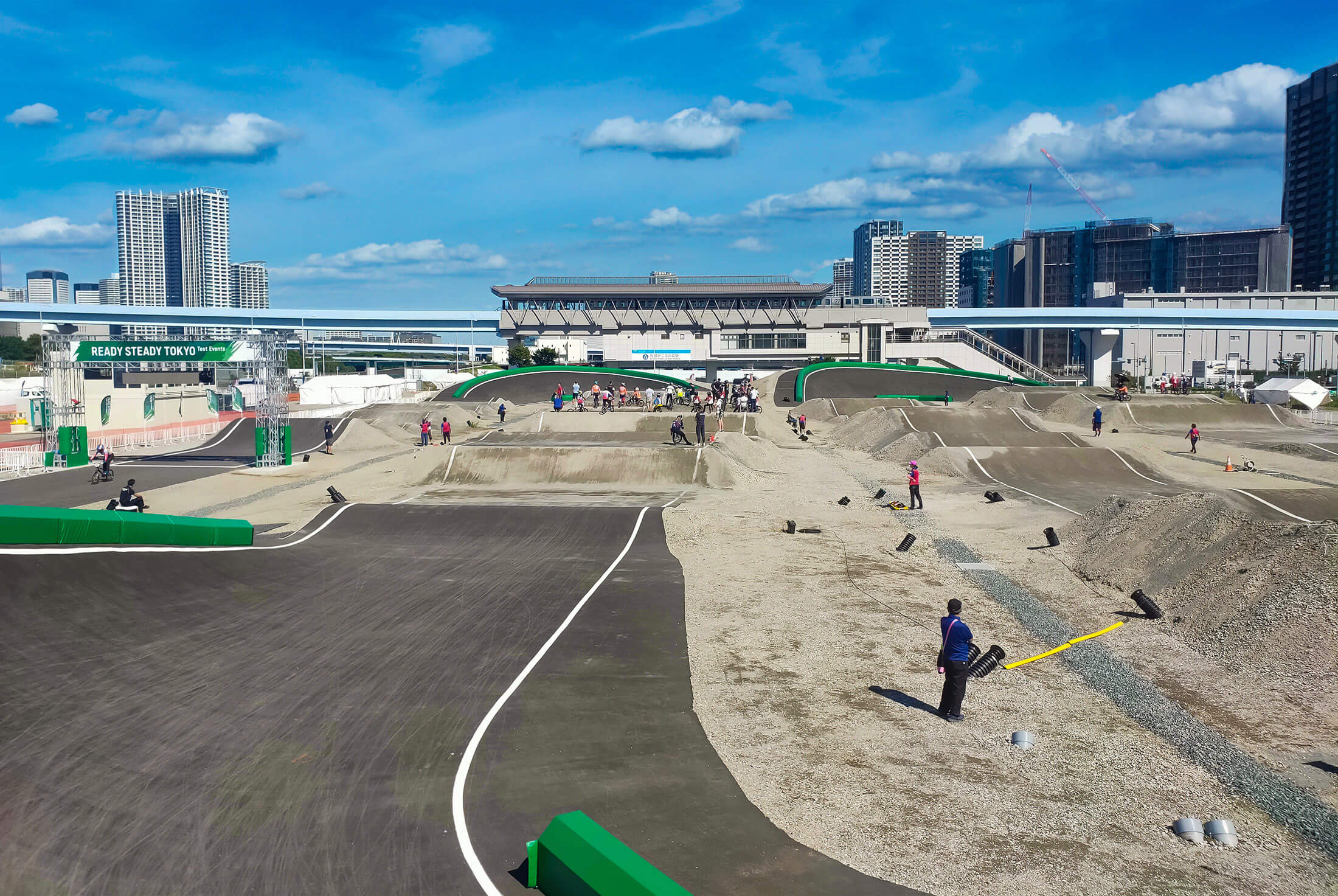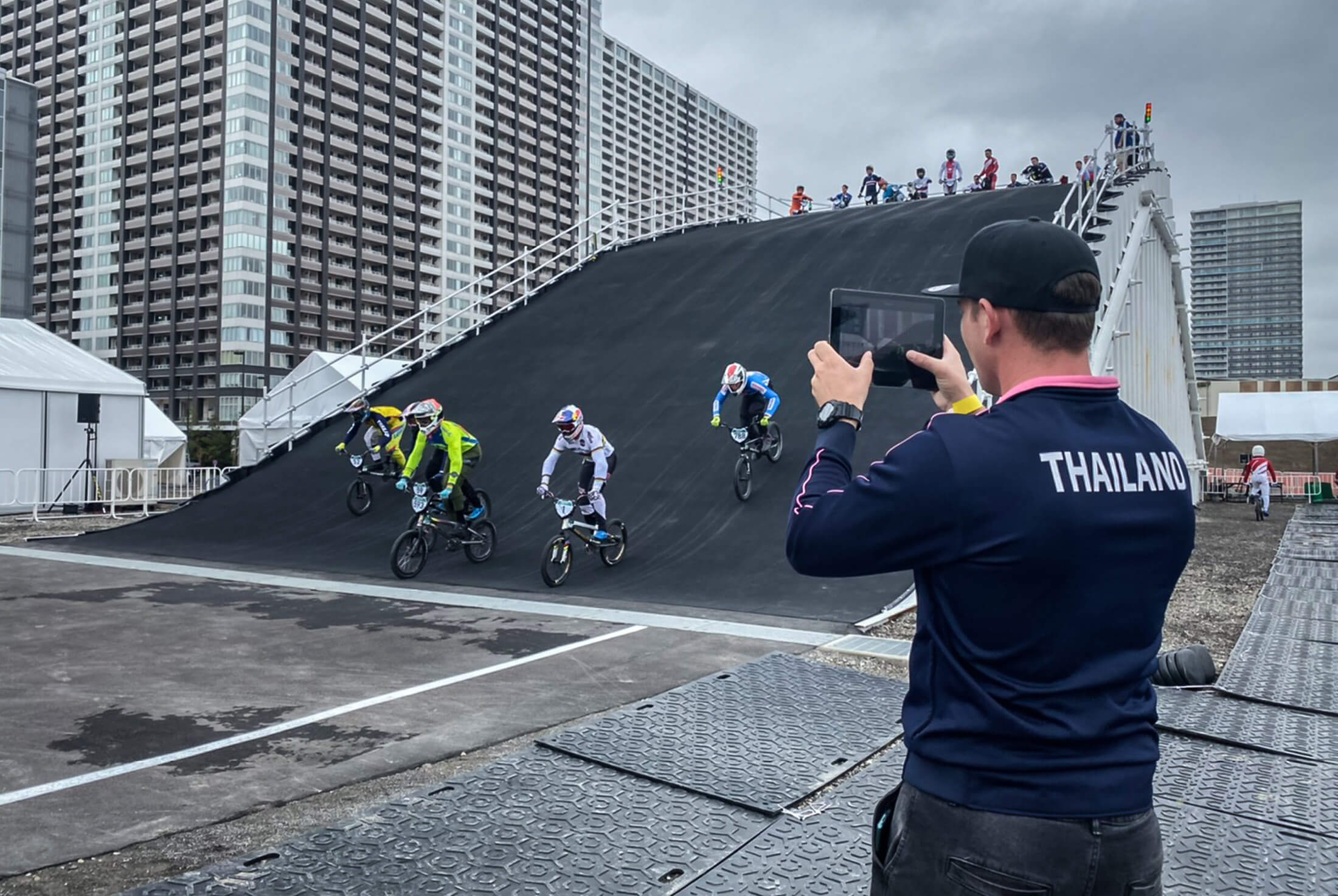On the ground at Ready, Steady, Tokyo!
The 2020 Olympic Test Event
By Adam Carey (Elite Rider and Thailand National Team Coach)
On the ground at Ready, Steady, Tokyo!
The 2020 Olympic Test Event
By Adam Carey (Elite Rider and Thailand National Team Coach)
Here we are facing down the end of 2019 and about the begin the final assault for Tokyo 2020. With the end of the Supercross season wrapping up in Argentina two weeks ago, the Olympic Test Event really came at a good time for riders and coaches to see what they are in for, should they qualify. When the crew at Fifteen found out I was going to the test event they asked me if I could throw some points together about the experience of the overall event and my observations from all things great and small.

My name is Adam Carey, I have been a BMXer since I was 9 and growing up in Australia watching Transit DVD’s I knew wanted to be a pro BMXer. I wanted to race like Bennett, Stumpy, Stevenson, Prokop, Nelson, Afro Bob, Allier, to name a few and fortunately I got to race most of those guys along my time but I always struggled to get the results I wanted. My friends always joke that 7th is my FINAL number. I love BMX racing and I knew I wanted to contribute to BMX in a way that my average results could not. Being a type 1 diabetic means I have to be as active as possible so I started coaching as a way to keep me on the bike and doing the thing that I love beyond words. I started my Bachelor’s degree in Sport Science in 2008 and have been working hard towards one of my major goals, to be an Olympic coach. What have I done so far to reach this goal? Helped coach multiple state, national and world champions in track, road, BMX, athletics and volunteering/interning in multiple national and international programs all to hopefully arrive at an Olympics where I helped athletes achieve their dreams (again, should we qualify). My coaching experience has seen me help athletes leading up to the last 2 Olympics (2012 and 2016) however, I have always had to stay home and watch on the big screen. This year I started working as the head BMX coach for Thailand. A country definitely attempting to improve BMX in their nation and a goal to get multiple qualifications come 2024. With the team consisting of 12 athletes and showing so much improvement the association told myself and the team manager ‘pack your bags, you’re heading to the Tokyo test event’.

I say all of this to give you context for what the Olympics are, what it means personally for every member involved, be it athletes, parents, coaches, officials, fans etc. It’s not just a goal for athletes, it’s a goal for everyone behind them too. For me, the notion of attending a Tokyo 2020 Olympic test event as head coach was f#*king cool, and a small taste of what I have wanted for the last 12 years.
The team and I flew into Tokyo and were greeted upon the arrival gates by some amazing staff. The hospitality shown by the organisers was fantastic. We got to the hotels, no stress, and everything was organised for us like the shuttles to and from the track, changes in the schedules were down in the hotel lobbies as well as practices times, ‘Oh man, what a cake walk’ I thought. That leads us to the first practice session and track walk. The track was built by Thomas Hamon at Protracks, who won the bid to build a brand-new design for the Olympics. Obviously, we all know the importance of this event and the significance behind where we are and what we are doing and it seemed to make things tense. The track certainly looked interesting and after a track walk and first practice session the riders and coaches discussed with the track crew some modifications they wanted to see before the event. Nothing major, just fix some lips and try to make the track more appropriate for the high speeds. One of the biggest changes from the previous Olympic tracks is the removal of the second pro straight and the introduction of a ‘hidden’ pro straight. This concept sounds fantastic but obviously proves harder than theorised, as we saw the women hit the biggest lines possible down that straight and the men flat land every jump possible down that straight. While it was not perfect, it was certainly raceable and everyone seemed to be able to hit it at speed. The third straight for both men and women was extremely difficult for the fact it was coming to the end of 350m. The track had well banked turns allowing some good corner lines and just like the China track (ProTracks Qiansen Trophy Track) some serious pedal room before those first jumps of the straight. It was noticeable how long the track was compared to the regular supercross tracks on the circuit, with one of the officials telling me the track length was close to 460m. This track was going to be a burn…
Practice was a reflection of how riders handled the track walk. As a coach, I found it interesting how riders adjusted to a brand-new track that was not on the circuit. Some riders who didn’t get things perfectly within three runs started to get frustrated and break habits, while some riders were going through practice and making the most of things. One thing that became apparent was that there were riders obviously here to race and riders obviously here to practice. The original schedule highlighted some serious practice time with one day of racing occurring on Sunday, however, typhoon Hagibis decided it would be coming by Tokyo to say hello on Saturday. This meant that the racing schedule was moved forward to Friday before the typhoon. Leaving only four hours of practice time before the race. With the games only having 24 spots for men and 24 spots for women this event was scheduled to run a different format than SX. Due to the time restraints, the impending typhoon and participant numbers the organisers decided the format was two qualification moto’s for top 24. Once top 24 was established it would be 3 x quarter final runs decided from UCI ranking, followed by a semi-final and a final. All in all, seven races!!!!!!
Friday, race day: The track adjustments were made like requested, rain was slowing the track speed and no moto looked easy. It was looking like it was going to be a tough day. The rain was coming in sporadically, the event organisers were attempting to stick to the schedule and overall everyone did a great job to see the start of racing was pretty close to time. There were certainly some differences between this event and what the actual Olympics will be like. Pit tents were located where the freestyle skate park is supposed to be, the coaches viewing platforms ended up being the corners (the second turn became the most popular iPad zone) and I doubt they will be putting walkway boards on the lip of the third straight to harden up the surface 15 minutes before racing starts. The first qualification races started and instantly it became clear some pacing strategies were in play for the length of the track. With qualifying lap times being 42 to 43 seconds for the men and 49 to 54 seconds for the women its noticeable this track is much longer than the typical supercross track. It was surprising to see some big names go out in qualifying, regardless of how stacked the moto’s were. This was also the end of my coaching day as my riders did not make top 24 in either men or women. It sucked, but they will continue to learn and it’s like the age old saying ’Rome wasn’t built in a day’. This was where we were supposed to be switching to the purely Olympic format of racing and the excitement starts ramping up.

Quarter final process: The top 24 riders from qualifying ended up in a quarter final depending upon their UCI ranking. They had to perform three races and average points within the top four in order to qualify for the semi-finals. I was expecting this to be faster than the previous races. Dude!!!! Was I wrong. The quarter finals were some of the most unentertaining races I have ever witnessed. Both men and women were pacing to get through the 3rd straight and after the first race, depending upon position some riders were pumping knowing they were in the semi. Some quarter finals had a higher race pace due to some fast-low UCI point riders but overall it was predictable for the men, pump fest for women and I doubt I will ever hear coaches yelling at their athletes to ‘chill’ coming around a second turn ever again. At the end of those 3 races there were some surprising non transfers and even some of the bigger names opting not to race their quarter and watch racing instead.
Semi-finals: This was changed to a single elimination race and the first full pace race we saw from the men and women. It was brutal watching them get to the line. This track bought out some game changers, we saw riders go from qualifying positions to missing out all down to the last straight. You could literally see riders fading coming around the last turn. The all-important gate start was looking like it was not as important as at most supercross tracks. The biggest shock from the semi’s was the DQ of Laura Smulders, where no one was informed of her relegation until the final or the reason why? This meant Bethany Shriever, who at this time was in her trackies and watching from turn two had made the final and did an extra few minutes of sprinting to get kitted up and on the gate.
Finals: Romain had a strong start from lane one and Niek from his old favourite, lane eight. Dean started strong as well but a double wheel case on the first jump had him sitting in 3rd. The race for the top two was single file and not much to report. The 3rd position got interesting with about three guys shopping behind Dean. It was Graf who came in and passed Dean down the last straight for the last spot on the box, which was impressive because he was solidly in 7th entering turn one. Alise had another incredible start in the final, as did Bethany Shriever who down the first straight started hauling from the outside. Saya Sakakibara was pushing the track times all qualifying and showed to have some serious track speed down the second straight, working her way past Bethany and getting Alise on the line. Bethany, from watching the final in trackies to on the gate in race kit faded into the last turn and ended up 6th. Stancil was riding strong all day and finished off with another event on the box. It was an entertaining and truly enduring race to watch.
It was interesting talking to other coaches about these observations, this track is not like the Supercross tracks we typically race. They have built this off a similar concept to the Qiansen track in China. A race where both years the men have run the women’s section. The length of the track and the difficulty of the third straight will likely prove a game changer. The second straight is non challenging for the men, but great for the women and the first straight is a drag strip which will reward the training that goes into BMX. From all accounts, this is the track we will be seeing come Tokyo 2020, where the quarter finals were really not what we have come to enjoy watching about BMX Supercross. I doubt that the games will have the same conservative energy but considering the observations, athletes and coaches may reconsider some training strategies from what has been previously tried and tested.
Overall the event was an experience and from my perspective an enlightening one. I learnt a lot, observed a lot and got a step closer to realising a goal I have been chasing for the last 12 years. The riders who were likely to win, won and everyone got some insight into the Olympic track. It will be interesting now to scroll through those Instagram and Facebook feeds to see what mad lab training goes down in the lead up to Tokyo… Keep those eyes peeled for what’s going down in order to achieve GOLD.
Follow Adam Carey on Instagram.